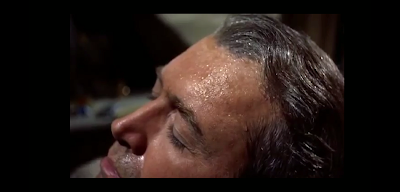Who's Watching the Peeping Tom? : The Multiple Narratives of Rear Window
Hitchcock when asked by Truffaut whether the (single viewpoint) technical challenge was the primary appeal for doing Rear Window, says-
"It was the possibility of doing a purely cinematic film. You have an immobilized man looking out, that's one part of the film. The second part shows what he sees and the third part shows how he reacts."
The very opening shot, a smooth pan reveals to us the broken leg of a LB Jeffries, along with a brief introduction of the space that the action is about to inhabit. On the story level it works as a apt introduction, setting us up for later conflict and final resolution.
But on a deeper level, the very opening is the audience's voyeuristic foray into the private space of Jeffries. He is asleep (which is diegetic, not accidental)
And within a matter of seconds we know all about him and his occupation.right before we settle ourselves to participate with Jeffries' later act of gazing, thus becoming centrally involved with a systematic critque unto our own selves.
The overt narrative is quite simple in terms of structure, adhering to causal classical norms, as described by Bordwell and Thomposon. A problem arrives and the narrative progresses towards the resolution. Other than the crisis of love, the narrative works on deeper levels. In fact, the tensions that we are presented with, that of love between the male and female protagonists which seem to propel Jeff into action, the drama that Jeff perceives and interprets are reflections of his own. It is not just inactivity and his proclivity for a voyeuristic outlook (for he is a photographer), there is a deeper fear of his involvement with Lisa. It's like he (unconciously-in the Freudian sense of the term) chooses a story to peep at, out of the many possible options.That's what drives him (and us, the audience).
In fact, if we consider this romantic tension as the core which leads the characters to function in a certain way, further read from a Freudian angle, Thorwalt almost works as the Id to Jeff's Super Ego.
The tensions they face are similar.
Raymond Bellour in 1979 analyzed Psycho as an exceptionally clear version of the 'Hitchcockian System', a film that announces in itself "the mechanisms that govern its operation," mechanisms provoked by problems of sexual difference and identity.
In Hitchcock's direction of the audience (for that is what he does) he leaves the viewer to infer and reconstruct the story from bits and pieces (this division being made clear by the different windows where the different stories are taking place- We are drawn into enigmas and demand solutions, something that Russian theorist M. Bakhtin called the 'impulse to continue' and the 'impulse to end'.
The second level then refers to the narrative and filmmaking process that underlies the viewer's involvement in such an adventure story. This unified aesthetic of realist motivations (arrangment of space-time patterns), are suddenly opened up and perceived as mechanical constructions of seeing and watching- and that too by the rules and conventions of cinema. Thus Rear Window conforms, in a cinematic way, to Bakhtin's 'autocritique novel' (where protagonists are either writers or readers- "living according to literature")
A deeper reading reveals a critique of viewer involvement woven into what is a traditional thriller. There are moments of intense suspense which really drive the narrative forward (where the viewer/audience has certain relevant information that the character herself doesn't have).
The interesting thing about the adaptation of the Cornell Woolrich short story is that the character of Jeffries that James Stewart plays, was in the story, an invalid investigator. Hitchcock changes that character to a photographer to initiate us into his critique of cinema and the very act watching.
References
1. Hitchcock-Truffaut
2. Ruth Perlmutter, 'Rear Window: A Construction Story'-
https://www.jstor.org/stable/20687662?seq=1#page_scan_tab_contents




















Comments
Post a Comment